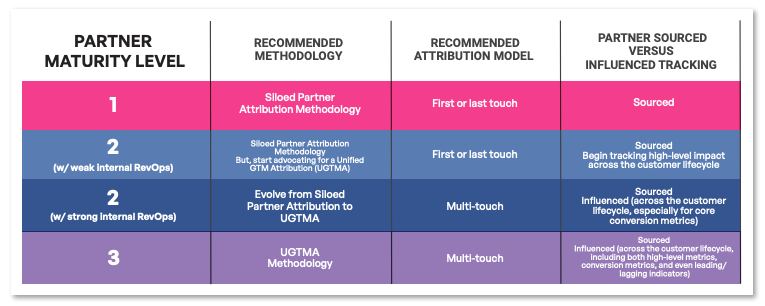The insights in this blog were pulled directly from the Partner Attribution Playbook. Download it for free.
Getting attribution right helps partnership teams secure resources, prove their value, and align with company goals. Yet, many teams grapple with misaligned metrics, unclear expectations, or an overcomplicated approach.
The key to solving these challenges lies in understanding where your organization stands in its journey of maturity. Whether you’re just starting with partner-sourced revenue or looking to integrate complex attribution models across multiple departments, your approach must match your current growth stage.
In this blog, we’ll break down how to identify your organization’s maturity level and implement the right attribution model to drive measurable impact.
What is Organizational Maturity?
Not every organization is ready for a complex attribution model. Pushing for advanced strategies too early can lead to wasted time, misaligned expectations, and frustrated teams. That’s why it’s critical to understand your organization’s maturity level before selecting an attribution approach.
Here are the three levels of organizational maturity and what they typically look like:
Level 1: We Want Partners To Do X
At this stage, partnerships are often siloed and seen as an experiment. Leadership focuses on one primary goal, typically partner-sourced revenue. Teams operate with limited resources and struggle to gain recognition across the organization.
Indicators:
- Minimal cross-functional collaboration.
- Vague or narrowly focused goals, such as “just source X revenue.”
- Attribution is limited to simple metrics like referral counts or closed deals.
Key Action: Start with a Siloed Partner Attribution model. Focus on proving value by tying activities directly to revenue. Keep your reporting simple and align with the most critical company goals.
Level 2: We Want Partners To Do XYZ
Here, partnerships begin to influence other areas of the business, such as increasing win rates or driving customer retention. Leadership recognizes the potential of partnerships beyond sourcing revenue, but the organization still operates with limited support and RevOps resources for partnerships functions.
Indicators:
- Partnerships contribute to multiple objectives, like influencing sales and improving customer experience.
- Collaboration with other departments starts to take shape, but alignment can be inconsistent.
- Leadership invests in partnerships but expects quick wins.
Key Action: Start by gaining strong RevOps support and then advocate for Unified GTM Attribution. Track both partner-sourced and partner-influenced metrics to show the broader impact of partnerships.
Level 3: Our Partner Ecosystem is a Strategic Asset
Organizations at this stage see partnerships as a strategic asset. The partnership ecosystem is embedded into the company’s operations and decision-making processes. Attribution spans multiple touchpoints across the entire customer lifecycle.
Indicators:
- A dedicated Chief Partnership Officer or equivalent executive role.
- High-level alignment across departments, including sales, marketing, and customer success.
- Comprehensive data systems and RevOps support complex attribution.
Key Action: Fully implement Unified GTM Attribution. Focus on multi-touch models that measure partner influence throughout the buyer’s journey. Use these insights to refine strategies and drive continuous improvement.
Attribution Models and How They Fit
Once you’ve identified your organization’s maturity level, the next step is selecting an attribution model that complements it. The wrong model can lead to misaligned expectations and unnecessary complexity, while the right one helps you demonstrate the value of partnerships effectively.
Siloed Partner Attribution
For organizations just starting to build their partner programs (Level 1), a straightforward Siloed Partner Attribution model often works best. This approach tracks partner-sourced activities independently, allowing teams to focus on direct contributions without overcomplicating reporting.
At this stage, simplicity is vital, with metrics like revenue sourced through referrals or deal registrations providing a clear picture of success. Implementation involves creating custom CRM fields to track partner activity and prioritizing one primary metric tied to organizational goals.
Unified GTM Attribution
As your organization matures into Level 2, partnerships begin influencing multiple business areas, such as boosting close rates or enhancing customer retention.
This is where the Unified GTM Attribution (UGTMA) model comes into play.
UGTMA integrates partner data with metrics from sales, marketing, and customer success, creating a comprehensive view of the customer journey. This approach requires collaboration across departments and strong RevOps support to effectively track both sourced and influenced contributions.
For highly mature organizations (Level 3), UGTMA becomes essential. Level 3 companies can measure the full impact of their partner ecosystem by:
- Mapping touchpoints across the buyer’s journey
- Assigning weight to each interaction
- Leveraging advanced RevOps systems
Multi-touch attribution models ensure that every stage, from lead generation to customer retention, reflects the influence of partnerships, fostering deeper alignment across teams.
Conclusion
The most effective attribution strategy is one that evolves with your organization. Start by being honest about where you are today. There’s no benefit in forcing a complex model onto an immature system.
Instead, focus on proving value incrementally, building trust with leadership, and aligning your goals with organizational priorities. As your maturity grows, don’t be afraid to revisit your approach.
When you’re ready for more attribution best practices, download the Partner Attribution Playbook. It’s free and gives you the tools to track and report your team’s contributions accurately, helping you secure resources, align with stakeholders, and demonstrate your value with confidence.




